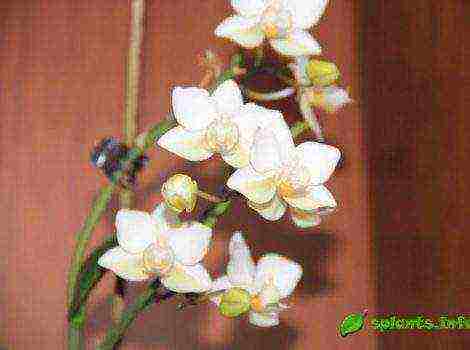Content
- 1 Choosing a dahlia variety that is suitable for growing in pots
- 2 Pot selection
- 3 Landing
- 4 Care
- 5 Pests and methods of dealing with them
- 6 Wintering dahlia
- 7 Growing seedlings of annual dahlias
- 8 Planting dahlias in open ground
- 9 Growing seedlings of annual dahlias
- 10 Planting dahlias in open ground
- 11 Can the tubers of annual dahlias be stored?
- 12 How to keep the tubers of annual dahlias until spring?
- 13 Can annual dahlias be made perennial?
- 14 The appearance of tubers in annual dahlias
- 15 Reviews
Dahlias popular among gardeners, despite their height, can be grown at home in pots. But at the same time, you need to take into account the specifics of growing and select the appropriate varieties.
Choosing a dahlia variety that is suitable for growing in pots
For planting dahlias at home or on the balcony, varieties with a small root system are selected. Special varieties of indoor low-growing dahlias have been developed - for growing in pots at home. These are pot-dahlias, miniature dahlias, etc. But you can also grow high varieties. It is important to choose the right container for planting and take care of the support if the flower has grown to 85-90 cm.
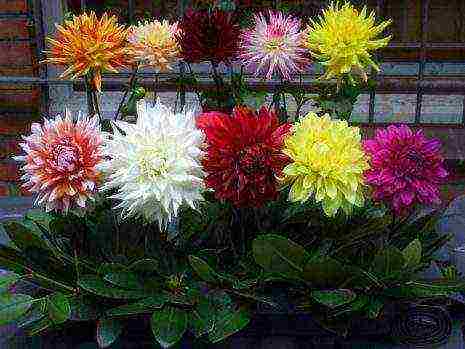
Pot selection
Indoor dahlias can be planted in plastic containers, wooden, wicker, clay, different sizes. What's better?
What container to use
In plastic containers, overheating of the soil is possible, the access of oxygen to the roots is reduced. Wicker baskets do not have these drawbacks, but they are usually short-lived. Wooden boxes are comfortable for flowers, but not decorative enough for a room or balcony. For attractiveness, they can be painted, but then air permeability is impaired. In a clay or ceramic pot, the roots of dahlias do not lack oxygen. These pots are attractive and durable.
I need to find a big pot
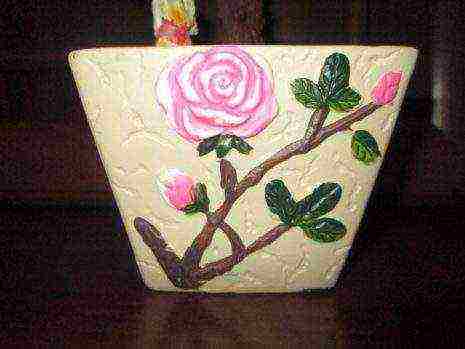
To plant a dahlia, you need a large pot. When choosing a volume, you should take into account the dimensions of the flowers. The size of the root system for low varieties requires a capacity of 4-5 liters. Medium-sized dahlias will feel comfortable in pots of 7-8 liters. For flowers with a height of more than 90 cm, 10 liters or more will be required.
Better to choose a heavy pot
The pot must be heavy.An adult dahlia requires a stable support, so plastic or wicker containers are not suitable. A thick-walled clay pot is able to provide the stability of the flower.
Drilling holes
Dahlias do not tolerate excess moisture. If the water stagnates in the pot after watering, the roots will die due to the lack of oxygen. It is necessary to ensure the outflow of water through the drainage holes. If there is only one drain hole, several more need to be drilled to improve drainage.
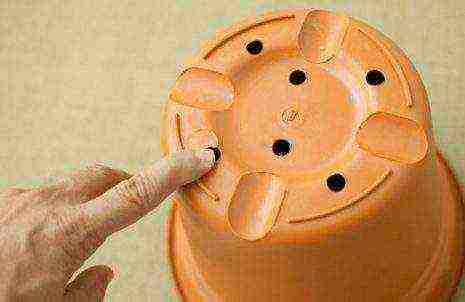
Why is it necessary to rinse the pot thoroughly?
When using already used pots, they must be pretreated. Clay can contain microorganisms, insect eggs, fungi, accumulate salts, etc. Therefore, before use, the pot should be thoroughly washed with soap and water and disinfected with a chlorine-free product.
Coarse soil mix
Dahlias are demanding on the quality of the soil. You can buy ready-made soil mix or mix it yourself. The soil should be coarse, loosened to provide air access to the roots. Peat, humus, sand are added to it. Experienced growers advise mixing perlite, hygroscopic granules of which remove excess moisture from the soil.
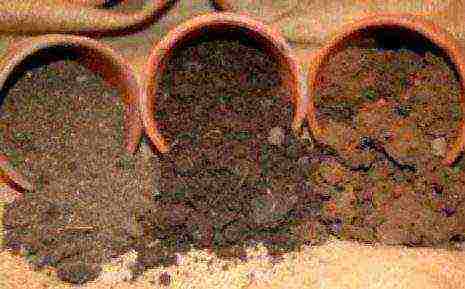
Landing
It is important to correctly determine the timing of planting so as not to spoil the planting material.
Landing dates
If the pots are in an apartment or on a heated balcony, then tubers can be planted as early as late March - early April. If the pots are planned to be exposed to the open air (on the porch, in the garden or on the open balcony), then it is better to wait until May, when even at night it will be at least 120C.
Potted dahlias begin to bloom about 45-50 days after planting. This period can be reduced by providing the plants with warmth and sunlight.
Filling the pot
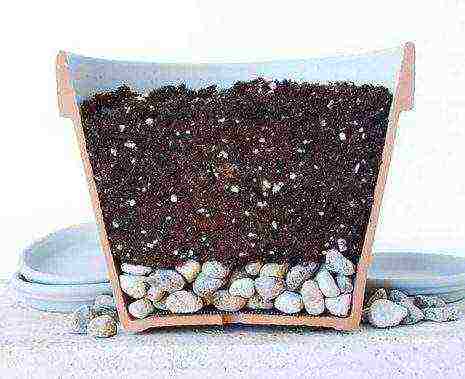
When filling the pot, pay special attention to the drainage layer.
ADVICE!
Experienced growers advise placing one or two coffee filters on the bottom of the pot. They absorb moisture well and block the drainage holes, blocking them from pests.
You can add gravel to the bottom of the pot. The height of the drainage layer is about 15 cm. The drainage holes must remain free to allow water to drain out. Soil is poured onto the drainage. The height of the soil depends on the pot - about 20 cm should be left to the top edge.
The tubers are planted to a depth of about 15 cm. After planting, germination and backfilling of tubers, the distance from the ground to the edge of the pot should be at least 2 cm. The backfilled soil is moistened and slightly crushed - the ground should be loose.
Planting tubers

Tubers with short roots should be planted. If the roots are allowed to elongate, they will intertwine and be damaged when untangled. Restoring the roots will delay the growth and flowering of the dahlia.
The tuber is laid on the ground with the eye upwards so that the stem can grow unhindered. It is desirable that the sprout is located approximately in the center of the pot, and the distance from the ends of the roots to the wall of the pot is at least 5-6 mm.
The tuber is sprinkled with moistened soil, you do not need to fill up the peephole. As the stem emerges and grows, the soil is added, but very carefully so as not to damage the delicate sprout. The addition of soil continues until the distance to the edge of the pot decreases to 2-3 cm.
The pot with the planted dahlia is placed in a warm, bright place protected from the wind. Slight shading is possible in the evening.
Watering the soil
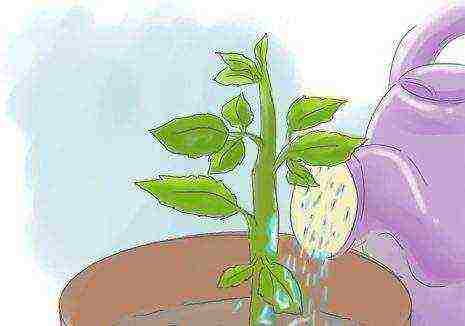 You may be interested in:
You may be interested in:
For planting, the soil is moistened. After planting, the dahlia does not require watering, the soil is only lightly sprinkled with warm water. Watering begins a few days later, after the formation of absorbent roots.
Fertilizers
For rapid growth and lush flowering, flowers require feeding. Dahlias respond well to fertilizers based on algae and fish, bone meal. You can buy a ready-to-use plant feed mixture at a specialty store.
Apply fertilizers with high nitrogen levels carefully. An excess of nitrogen leads to diseases of dahlias, they bloom poorly, tubers do not tolerate wintering well.
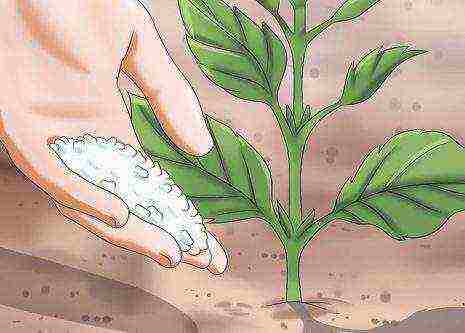
Inserting a stanchion and anchoring the stem
For flowers of medium to tall growth, additional support will be required so that the stem can support the weight of the flower. As a rule, the height of the support does not exceed 120 cm. The support must be stable - it is inserted into the ground to the very bottom and, if necessary, additionally attached to the pot (for example, using a wire).
The stem is carefully tied to the support.
ADVICE!
Dahlias do not tolerate transplanting well, so experienced flower growers advise to immediately plant the tuber in a pot in which the flower will grow.
Care
Caring for potted dahlias is simple and includes:
- watering,
- loosening of the soil,
- top dressing,
- protection from diseases and pests.
If potted dahlias grow in the open air (on an open balcony, veranda, porch), then in adverse weather conditions they are simply temporarily brought into the room.
Watering the stem and soil
Dahlias do not tolerate excess moisture. Watering frequency depends on the weather. This is usually two to three times a week. If it's cool, just once is enough, depending on the condition of the soil. In dry and hot weather, you can water daily without allowing moisture to stagnate.
ADVICE!
After watering, it is necessary to loosen the soil. Otherwise, a dried earth crust is formed, which does not allow oxygen to pass to the roots.
Lighting
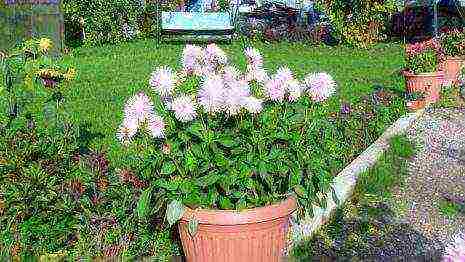
Dahlias love sunlight. For high-quality growth and flowering, they need about 6-8 hours to be in direct sunlight. If the pots are on the balcony, choose the sunniest place for them. If dahlias are growing in a room, then it is useful to make up for the lack of sunlight with fluorescent lamps. The lamp can be installed immediately after planting at a level of 15 cm above the ground. As the dahlia grows, the lamp rises.
Fertilizer timing
Dahlias need a lot of potassium and phosphorus, to a lesser extent - nitrogen. Top dressing begins in June. Fertilizers are applied every two weeks when watering. Overfeeding with fertilizers should be avoided. Top dressing continues until September.
Removing the lower leaves
Around mid-July, the lower leaves are removed from the stem to improve air circulation. It also protects plants from powdery mildew disease.

Spraying with insecticide and fungicide
To protect against pests, potted dahlias are treated with a fungicide or insecticide twice a month.
Pests and methods of dealing with them
Yellowed and curled leaves are a signal of the appearance of aphids. If the colonies are single, then the damaged leaves are simply removed. In case of severe infection, an insecticide treatment is necessary.
Slugs gnaw through or completely destroy the leaves. To combat them, metaldehyde preparations, superphosphate, red pepper are effective - they scatter on the ground.
Plant bugs cause leaf boring. To get rid of them, dahlias are sprayed with insecticide. The treatment is best done in the morning, when the bugs are inactive.
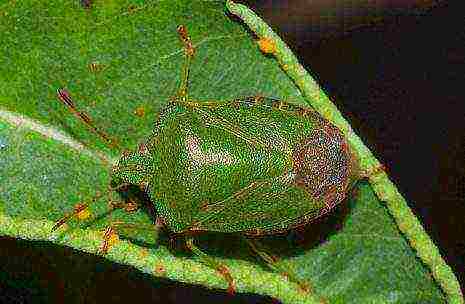
Earwigs spoil the buds, gnawing out their core. Watering once a week with a decoction of wormwood or celandine helps from earwigs.
When mold appears, fungicide treatment helps.
In case of a disease with powdery mildew, treatment with a preparation containing copper is necessary. Sulfur treatment can be applied.
Wintering dahlia
With the first autumn frosts, even if dahlias grow in the house, you need to think about winter rest. Before winter, the dahlia is cut, leaving 4-5 cm of the stem. The tubers can be dug up or left in the same pots in which they grew.
The dug tubers are carefully cleaned from the ground, treated with a solution of potassium permanganate of medium brightness and dried. They are stored in a cool dry place at an air temperature of about 50C. So that they do not dry out during storage, the tubers can be sprinkled with sawdust, sand, peat.

During wintering, protruding roots are cut off in a pot, the pot is wrapped in newspaper in several layers and packed in an opaque bag. Until spring, the pots should be kept in a cool dry place.
Other entries about dahlias
Hello! Help me determine which dahlias I have grown. Planted as one-year-olds. Today I went to dig them up in order to free up space for planting. And what was my shock when I saw the tubers !!! I dug a second bush - and there ...
Good afternoon. My question is more to flower growers. I recently discovered the splendor of dahlias, preferring undersized curbs. Please tell me when it is time to "wake up" the tubers and how to divide them correctly so as not to damage them. They say you need to ...
A question from our subscriber Svetlana: I found dahlia seeds among the seeds of vegetables. I know about what to do with their corms, but this is the first time I come across seeds. Do they need to be grown through seedlings? How and in what month to sow? Which…
Hello dear florists and gardeners. I have a question for you. Why dahlia tubers, purchased from one of the companies that breed different plants, do not wake up. And what about them? And the heart will not allow it to be thrown out, and to look at this sleepy ...
Dear friends! This year I have already sowed seeds of one-year-old georgions "Merry Children" for seedlings 3 times. NOTHING springs up !!! I changed the soil, peat tablets, seed producers. The result is zero. Am I doing something wrong? Share ...
Dahlias are beautiful perennials that are very popular with gardeners. They attract with bright large inflorescences, a long flowering period and a wide variety of varieties and hybrids for every taste. They are thermophilic, therefore tuberous species ...
See all materials
about dahlias :
See all
How to grow annual dahlias
- Choosing a variety of annual dahlias.
- Sowing seeds in open ground.
- Growing seedlings of annual dahlias.
- Planting dahlias in the ground.
- Caring for annual dahlias.
- Growing of annual dahlias in pots and flowerpots.
- How to save tubers.
- Dahlias in garden design.
Growing annual dahlias is a snap. Planting and caring for these annuals will be within the power of even inexperienced growers. In addition, growing annual dalys has its own advantages:
- Unlike perennial varieties of dahlias, annual varieties are excellently grown from seed. There is no easy task - to dig up and store tubers until spring. It is enough to buy seeds of the kind you like and plant them in the spring.
- Growing seedlings allows you to get flowering plants as early as June.
- The flowering of annual varieties is lush and long (lasts until the very frost).
- At a cost, dahlia seeds are much cheaper than tubers, and more plants can be grown.
What is the difference between varieties of annual dahlias
Depending on the variety, annual dahlias differ in height, flowering time, shape and size of the inflorescence
- Low-growing varieties with a height of 15-20 cm to 45-60 cm.
- Medium-sized varieties grow up to 1-1.2 m.
- Dwarf varieties begin to bloom much earlier than taller varieties.
- In shape, inflorescences are simple, semi-double, double, cactus, pompom.
On the seed bags, the manufacturer gives a description of the variety, sowing and flowering dates. Based on this information, it is easy to select the right variety depending on the planting location. For growing annuals on the balcony, in pots and flowerpots, and for decorating borders and the foreground of mixborders, dwarf varieties are suitable, which are distinguished by early and intense flowering on compact bushes.
Popular varieties of low-growing dahlias: Merry Guys, Figaro, Dandy, Bambino, Vasilisa, Piccolo, etc.
Higher distances can be planted in flower beds and mixborders, in beds, along the fence and wall. Medium-sized annual dahlias: Bright pom-poms, Cactus mix.
There are two options for growing annual dahlias:
- Sowing seeds directly into the ground.
- Growing through seedlings.
Sowing seeds in open ground
Annual dahlias can be grown by sowing seeds directly in open ground. Dahlia do best on light, breathable, neutral or slightly acidic soils. Preplant preparation of the land can be carried out in the fall or spring. Add rotted manure, humus, compost to the site for dahlias. Coarse sand and ash will help improve the structure of heavy earth.
When to plant. When determining the sowing time, it should be borne in mind that sprouts appear within a week. Therefore, it is possible to plant seeds in open ground when there is no threat of frost.
Landing. The seeds are buried 1-1.5 cm with an interval of about 30 cm. Since some seeds may not germinate, it is better to plant 2 or 3 seeds next to each other at once. Subsequently, if friendly shoots have turned out, you can leave one, the most powerful plant, and transplant the rest to another place.
Water the crops, mulch or cover with foil to retain moisture.
Growing seedlings of annual dahlias
Growing annual dalys through seedlings allows you to get flowering plants as early as June. In the first half of March, you can start sowing seeds.
A light substrate is poured into a plastic container with drainage holes in a layer of up to 5-7 cm. You can buy ready-made soil or prepare it yourself by mixing 2 parts of sod land with 1 part of humus and 1 part of sand. Perlite or vermiculite is sometimes added instead of sand.
We sow seeds. Before sowing, it is advisable to spill the soil with a solution of potassium permanganate or phytosporin to prevent fungal diseases. Spread the seeds on the surface and cover them with a layer of soil up to 1.5 cm. Carefully water the crops and cover with foil. In a warm, bright place, seedlings will appear on the 5-7th day.
How to care for seedlings. As soon as the sprouts hatch, the film must be removed and provided with good lighting and an optimal temperature of about 20 degrees. If there is not enough light, additional lighting should be organized. In poor light, the seedlings stretch out strongly.
Watering should be moderate as the soil dries. Dahlias cannot stand waterlogging, which can lead to the development of the disease - black leg.
Picking. In the phase of two true leaves, dahlias dive into separate pots, deepening the plants to the cotyledonous leaves.
Two weeks after the pick, the seedlings can be fed with complex fertilizer. After ten days, repeat the feeding. Top dressing should be carried out on wet soil so as not to burn the delicate roots of young plants.
Above the third pair of real leaves, you need to pinch the top. As a result, side shoots will grow, the bushes will be more lush.
Planting dahlias in open ground
Before planting in the garden, the seedlings must be hardened. Plants begin to take out into fresh air, increasing the residence time. As soon as the threat of frost has passed, dahlias can be planted in a prepared place.
The site for planting Daliy should be sunny with light fertile soil. Humus or compost can be added to the planting hole, mixed with the ground. Two hours before planting, water the seedlings well. It is necessary to transfer the plants to the planting hole together with a lump of earth so as not to injure the roots. So the bushes will take root faster.
The distance between plants depends on the variety. For undersized dahlias, the gap is 30 cm, for higher species - 50 cm. Water and mulch the planted plants.
Caring for annual dahlias
Annual dahlias are undemanding in care, which consists in watering, weeding and feeding.
Watering
Dahlias do not like prolonged waterlogging, so you need to water the plants as the soil dries out. In dry hot weather, watering can be increased up to twice a week. After watering, it is advisable to mulch the soil. Mulching helps to retain moisture longer and does not form a crust on the soil surface.
Weeding
Weeding is necessary to keep the area around the dahlias clean. Weeds take moisture and nutrients from plants, and the access of light is impaired. Weeding is best done on the second or third day after watering, while loosening the soil. Loosening improves the air permeability of the soil and reduces moisture evaporation.
Top dressing
At the beginning of the growing season, our dahlias need nitrogen to build up green mass. Therefore, if organic fertilizers were not applied to the planting hole when planting seedlings, you can feed the plants with mullein infusions (2 liters of infusion per 10 liters of water). Top dressing should be carried out one week after transplanting. The day before fertilizing, the flowers must be watered.
During the period of budding and flowering, dahlias need phosphorus-potassium supplements. Potassium sulfate and superphosphate or a compound fertilizer with a low nitrogen content are suitable. Two dressings are enough: during budding and at the beginning of flowering.
With an excess of nitrogen, the dahlia bushes begin to "fatten", i.e. to increase the green mass to the detriment of flowering. In addition, such plants are more susceptible to infection with fungal diseases.
Timely removal of wilting inflorescences allows dahlias to bloom longer, because the plant does not waste energy on seed ripening and begins to release new buds.
As you can see, caring for dahlias is ordinary and not at all difficult.
Growing dahlias in pots and flowerpots
For growing annuals in pots and flowerpots, dwarf varieties are excellent. Bushes of dwarf dahlias grow no more than 40-50 cm. Flowering begins in June and continues until autumn frosts. Many low-growing varieties of dahlias have been developed, suitable for growing in pots and containers, which grow in a low compact bush with abundant flowering.
Pots should be spacious (at least 5 L) with good drainage holes for water to drain. At the bottom you need to pour a layer of expanded clay. Lightly breathable, neutral or slightly acidic soil is used for planting. Good results are obtained by adding hydrogel, vermiculite, perlite. These additives accumulate excess moisture and then release it as the soil dries out.
Before planting, it is advisable to spill the soil with a solution of potassium permanganate or phytosporin for the prevention of diseases.
Taking care of dahlias planted in flowerpots is somewhat more difficult than in the open field. Care will consist in more frequent watering, top dressing, timely removal of faded baskets. Fertilizers are applied after watering once every two weeks. It is convenient to use complex liquid fertilizers. In August, all feeding is stopped.
In the fall, before the onset of frost, dahlias can be brought into a warm room, and they will delight with their flowering for some time.
How to save tubers
Annual dahlias grown through seedlings, under good conditions, manage to form tubers in a season. In the fall, after the first frost, these tubers can be dug up and stored in a basement or other room with a temperature of about 5 degrees.
Low-growing dahlias form small nodules that can dry out during storage. Therefore, it is better to store them covered with earth, peat or sawdust. Some gardeners leave the tubers for storage in pots that dahlias have grown in all summer. But it must be borne in mind that after a couple of years, the tubers begin to degenerate, and it will be necessary to update the variety by sowing seeds.
The seeds can be harvested on their own, leaving a few faded baskets to dry completely. But dahlias grown from such seeds are likely to be unlike the mother plant.
Annual dahlias in garden design
Due to the variety of colors and shapes, annual dahlias can be planted in separate groups, creating bright spots among the greenery of the garden, or together with other annuals.Here it is important to choose a good combination of colors of inflorescences and avoid excessive variegation.
Dahlias go well in flower beds and mixborders with delphinium, phlox, lobelia. Asters, cosmos and zinnias in matching colors can also make a pleasant company.
Cactus and pompom dahlias that grow up to 1 m tall will look good in the background of a flower bed or mixborder. Ornamental sunflowers can be planted next to them.
Dwarf varieties are suitable for decorating the border, rabatka and foreground of a mixborder. An excellent addition to them will be undersized marigolds and marigolds with their yellow-orange color palette.
Dahlias planted in pots, flowerpots can be placed on terraces and verandas, near garden benches and gazebos.
Diseases and pests of annual dahlias
Annual dahlias can be affected by fungal and viral diseases. Most common: gray rot, white rot, fusarium, black leg, viral mosaic.
Such pests as aphids, scoop caterpillars, slugs and snails love to feast on juicy green shoots and delicate petals of annual dalys.
To protect your flowers from diseases and pests, it is important to follow the growing rules and carry out preventive plant treatments.
An interesting video about the care of annual dahlias
Other helpful articles about dahlias
- Varieties of perennial and annual dahlias. On this page you can familiarize yourself with the most different types of dahlias. There are small ones (which can be planted in pots or on the balcony), and there are large and simply huge ones.
- Growing perennial dahlias. Detailed advice on choosing a site, planting dates, preparing tubers, growing seedlings and much more.
- Dahlia diseases and pests. The most effective methods for controlling pests and treating diseases of your flowers.
- When to dig up and how to store the tubers. Dahlias must not only be dug up on time, but also preserved during the winter. How best to do this in an apartment, read this article.
Save article to:
Dear visitors of the "Dacha Plot", tireless gardeners, gardeners and flower growers. We offer you to pass the aptitude test and find out whether you can trust the shovel and let you into the garden with it.
Test - "What kind of summer resident I am"
Share this article with your friends:
How to grow annual dahlias
- Choosing a variety of annual dahlias.
- Sowing seeds in open ground.
- Growing seedlings of annual dahlias.
- Planting dahlias in the ground.
- Caring for annual dahlias.
- Growing of annual dahlias in pots and flowerpots.
- How to save tubers.
- Dahlias in garden design.
Growing annual dahlias is a snap. Planting and caring for these annuals will be within the power of even inexperienced growers. In addition, growing annual dalys has its own advantages:
- Unlike perennial varieties of dahlias, annual varieties are excellently grown from seed. There is no easy task - to dig up and store tubers until spring. It is enough to buy seeds of the kind you like and plant them in the spring.
- Growing seedlings allows you to get flowering plants as early as June.
- The flowering of annual varieties is lush and long (lasts until the very frost).
- At a cost, dahlia seeds are much cheaper than tubers, and more plants can be grown.
What is the difference between varieties of annual dahlias
Depending on the variety, annual dahlias differ in height, flowering time, shape and size of the inflorescence
- Low-growing varieties with a height of 15-20 cm to 45-60 cm.
- Medium-sized varieties grow up to 1-1.2 m.
- Dwarf varieties begin to bloom much earlier than taller varieties.
- In shape, inflorescences are simple, semi-double, double, cactus, pompom.
On the seed bags, the manufacturer gives a description of the variety, sowing and flowering dates.Based on this information, it is easy to select the right variety depending on the planting location. For growing annuals on the balcony, in pots and flowerpots, and for decorating borders and the foreground of mixborders, dwarf varieties are suitable, which are distinguished by early and intense flowering on compact bushes.
Popular varieties of low-growing dahlias: Merry Guys, Figaro, Dandy, Bambino, Vasilisa, Piccolo, etc.
Higher distances can be planted in flower beds and mixborders, in beds, along the fence and wall. Medium-sized annual dahlias: Bright pom-poms, Cactus mix.
There are two options for growing annual dahlias:
- Sowing seeds directly into the ground.
- Growing through seedlings.
Sowing seeds in open ground
Annual dahlias can be grown by sowing seeds directly in open ground. Dahlia do best on light, breathable, neutral or slightly acidic soils. Preplant preparation of the land can be carried out in the fall or spring. Add rotted manure, humus, compost to the site for dahlias. Coarse sand and ash will help improve the structure of heavy earth.
When to plant. When determining the sowing time, it should be borne in mind that sprouts appear within a week. Therefore, it is possible to plant seeds in open ground when there is no threat of frost.
Landing. The seeds are buried 1-1.5 cm with an interval of about 30 cm. Since some seeds may not germinate, it is better to plant 2 or 3 seeds next to each other at once. Subsequently, if friendly shoots have turned out, you can leave one, the most powerful plant, and transplant the rest to another place.
Water the crops, mulch or cover with foil to retain moisture.
Growing seedlings of annual dahlias
Growing annual dalys through seedlings allows you to get flowering plants as early as June. In the first half of March, you can start sowing seeds.
A light substrate is poured into a plastic container with drainage holes in a layer of up to 5-7 cm. You can buy ready-made soil or prepare it yourself by mixing 2 parts of sod land with 1 part of humus and 1 part of sand. Perlite or vermiculite is sometimes added instead of sand.
We sow seeds. Before sowing, it is advisable to spill the soil with a solution of potassium permanganate or phytosporin to prevent fungal diseases. Spread the seeds on the surface and cover them with a layer of soil up to 1.5 cm. Carefully water the crops and cover with foil. In a warm, bright place, seedlings will appear on the 5-7th day.
How to care for seedlings. As soon as the sprouts hatch, the film must be removed and provided with good lighting and an optimal temperature of about 20 degrees. If there is not enough light, additional lighting should be organized. In poor light, the seedlings stretch out strongly.
Watering should be moderate as the soil dries. Dahlias cannot stand waterlogging, which can lead to the development of the disease - black leg.
Picking. In the phase of two true leaves, dahlias dive into separate pots, deepening the plants to the cotyledonous leaves.
Two weeks after the pick, the seedlings can be fed with complex fertilizer. After ten days, repeat the feeding. Top dressing should be carried out on wet soil so as not to burn the delicate roots of young plants.
Above the third pair of real leaves, you need to pinch the top. As a result, side shoots will grow, the bushes will be more lush.
Planting dahlias in open ground
Before planting in the garden, the seedlings must be hardened. Plants begin to take out into fresh air, increasing the residence time. As soon as the threat of frost has passed, dahlias can be planted in a prepared place.
The site for planting Daliy should be sunny with light fertile soil. Humus or compost can be added to the planting hole, mixed with the ground. Two hours before planting, water the seedlings well. It is necessary to transfer the plants to the planting hole together with a lump of earth so as not to injure the roots.So the bushes will take root faster.
The distance between plants depends on the variety. For undersized dahlias, the gap is 30 cm, for higher species - 50 cm. Water and mulch the planted plants.
Caring for annual dahlias
Annual dahlias are undemanding in care, which consists in watering, weeding and feeding.
Watering
Dahlias do not like prolonged waterlogging, so you need to water the plants as the soil dries out. In dry hot weather, watering can be increased up to twice a week. After watering, it is advisable to mulch the soil. Mulching helps to retain moisture longer and does not form a crust on the soil surface.
Weeding
Weeding is necessary to keep the area around the dahlias clean. Weeds take moisture and nutrients from plants, and the access of light is impaired. Weeding is best done on the second or third day after watering, while loosening the soil. Loosening improves the air permeability of the soil and reduces moisture evaporation.
Top dressing
At the beginning of the growing season, our dahlias need nitrogen to build up green mass. Therefore, if organic fertilizers were not applied to the planting hole when planting seedlings, you can feed the plants with mullein infusions (2 liters of infusion per 10 liters of water). Top dressing should be carried out one week after transplanting. The day before fertilizing, the flowers must be watered.
During the period of budding and flowering, dahlias need phosphorus-potassium supplements. Potassium sulfate and superphosphate or a compound fertilizer with a low nitrogen content are suitable. Two dressings are enough: during the budding period and at the beginning of flowering.
With an excess of nitrogen, the dahlia bushes begin to "fatten", i.e. to increase the green mass to the detriment of flowering. In addition, such plants are more susceptible to infection with fungal diseases.
Timely removal of wilting inflorescences allows dahlias to bloom longer, because the plant does not waste energy on seed ripening and begins to release new buds.
As you can see, caring for dahlias is ordinary and not at all difficult.
Growing dahlias in pots and flowerpots
For growing annuals in pots and flowerpots, dwarf varieties are excellent. Bushes of dwarf dahlias grow no more than 40-50 cm. Flowering begins in June and continues until autumn frosts. Many low-growing varieties of dahlias have been developed, suitable for growing in pots and containers, which grow in a low compact bush with abundant flowering.
Pots should be spacious (at least 5 L) with good drainage holes for water to drain. At the bottom you need to pour a layer of expanded clay. Lightly breathable, neutral or slightly acidic soil is used for planting. Good results are obtained by adding hydrogel, vermiculite, perlite. These additives accumulate excess moisture and then release it as the soil dries out.
Before planting, it is advisable to spill the soil with a solution of potassium permanganate or phytosporin for the prevention of diseases.
Taking care of dahlias planted in flowerpots is somewhat more difficult than in the open field. Care will consist in more frequent watering, top dressing, timely removal of faded baskets. Fertilizers are applied after watering once every two weeks. It is convenient to use complex liquid fertilizers. In August, all feeding is stopped.
In the fall, before the onset of frost, dahlias can be brought into a warm room, and they will delight with their flowering for some time.
How to save tubers
Annual dahlias grown through seedlings, under good conditions, manage to form tubers in a season. In the fall, after the first frost, these tubers can be dug up and stored in a basement or other room with a temperature of about 5 degrees.
Low-growing dahlias form small nodules that can dry out during storage. Therefore, it is better to store them covered with earth, peat or sawdust.Some gardeners leave the tubers for storage in pots that dahlias have grown in all summer. But it must be borne in mind that after a couple of years, the tubers begin to degenerate, and it will be necessary to update the variety by sowing seeds.
The seeds can be harvested on their own, leaving a few faded baskets to dry completely. But dahlias grown from such seeds are likely to be unlike the mother plant.
Annual dahlias in garden design
Due to the variety of colors and shapes, annual dahlias can be planted in separate groups, creating bright spots among the greenery of the garden, or together with other annuals. Here it is important to choose a good combination of colors of inflorescences and avoid excessive variegation.
Dahlias go well in flower beds and mixborders with delphinium, phlox, lobelia. Asters, cosmos and zinnias in matching colors can also make a pleasant company.
Cactus and pompom dahlias that grow up to 1 m tall will look good in the background of a flower bed or mixborder. Ornamental sunflowers can be planted next to them.
Dwarf varieties are suitable for decorating the border, rabatka and foreground of a mixborder. An excellent addition to them will be undersized marigolds and marigolds with their yellow-orange color palette.
Dahlias planted in pots, flowerpots can be placed on terraces and verandas, near garden benches and gazebos.
Diseases and pests of annual dahlias
Annual dahlias can be affected by fungal and viral diseases. Most common: gray rot, white rot, fusarium, black leg, viral mosaic.
Such pests as aphids, scoop caterpillars, slugs and snails love to feast on juicy green shoots and delicate petals of annual dalys.
To protect your flowers from diseases and pests, it is important to follow the growing rules and carry out preventive plant treatments.
An interesting video about the care of annual dahlias
Other helpful articles about dahlias
- Varieties of perennial and annual dahlias. On this page you can familiarize yourself with the most different types of dahlias. There are small ones (which can be planted in pots or on the balcony), and there are large and simply huge ones.
- Growing perennial dahlias. Detailed advice on choosing a site, planting dates, preparing tubers, growing seedlings and much more.
- Dahlia diseases and pests. The most effective methods for controlling pests and treating diseases of your flowers.
- When to dig up and how to store the tubers. Dahlias must not only be dug up on time, but also preserved during the winter. How best to do this in an apartment, read this article.
Save article to:
Dear visitors of the "Dacha Plot", tireless gardeners, gardeners and flower growers. We offer you to pass the aptitude test and find out whether you can trust the shovel and let you into the garden with it.
Test - "What kind of summer resident I am"
Share this article with your friends:
Nowadays there are a lot of different annual dahlias from the "Funny Guys" series. Their color is quite varied and with their appearance they beautifully decorate various flower beds and rabatki.
Can the tubers of annual dahlias be stored?
The actual cultivation of annual dahlias is not particularly difficult, they grow small bulbs (tubers) by autumn, and then the question arises, how can they be stored in winter for planting next year? After all, the color you like from the seeds for the next year may not work out, since the shade of flowers is not transmitted by the seeds.
The most popular varieties of annual dahlias are:
- "Merry guys" - the bushes of this variety reach a height of 90 cm. Flowers bloom large and non-double.
- "Minion Mishung" bush height is 50 cm, blooms with small non-double flowers.
- "Rigolleto" - the height of the bush is 50 cm, the blossoming buds are semi-double and small in diameter.
It is, of course, possible to save the root of the bush you like, but this will require certain skills, since the one-year-old is more difficult to keep in the winter due to their too small tubers. And because of their small size, they quickly lose moisture. Therefore, it is necessary to find a storage method in which thin tubers will feel good.
IMPORTANT! A place and method is selected so that thin tubers do not lose moisture and remain firm and elastic.

How to keep the tubers of annual dahlias until spring?
Annual dahlias are stored in the same ways as perennial dahlias, only so that there is not a large lunge of tubers, you need to carefully monitor the humidity in the place where the tubers are stored. Therefore, when digging a dahlia, the tubers are divided into 3-4 groups and they try to preserve these groups in various available ways, choosing exactly what will be best for them in the conditions of a particular grower residence. Even storage in a basement will work well in one case, and in another case, the tubers will die. It depends on various parameters:
- basement temperature in winter;
- from moisture;
- from too dry air at elevated temperatures.
IMPORTANT! To select a storage place for tubers by experimenting with different places and methods, therefore, they divide the tubers into different groups in order to be determined in one winter period without large attacks of rhizomes.
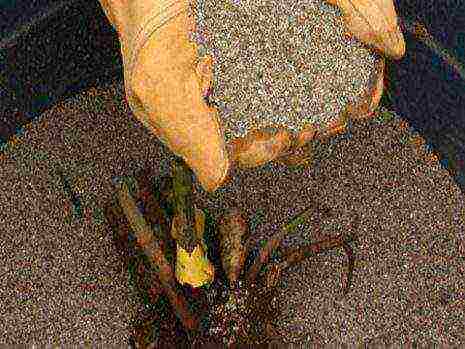
Dahlia digging
Before you start storing tubers, you need to dig them up correctly. At the first subzero temperatures, the foliage and stems of the plant turn black and they must be cut off, leaving a stump no more than 5 cm above the ground, they do this during a period when there is no rain so that the main stem of the plant does not start to rot.
When digging a bush, it must be dug from all sides so as not to damage the thin roots and only then remove everything from the soil. Having dug up the rhizome, shake off the ground and remove the spoiled tubers so that they do not damage the rest.
IMPORTANT! The tubers that have been selected for storage are washed well in warm water and soaked for a couple of hours in a pink solution of potassium manganese. This is a tubers disinfection procedure.

Storage methods for annual dahlias
Storing tubers in the basement - so that thin tubers do not dry out, cardboard boxes and sand are required. Sand can be replaced with sawdust. First of all, there must be certain conditions in the basement during the winter:
- Air humidity should be 60%.
- The air temperature should be within + 3-5 degrees.
Sawdust or sand is poured into a box on the bottom with a layer of 4 cm, dahlia tubers are laid out in one layer in such a way that they do not touch each other. There can be up to 5 such layers in a box, the main thing is that the height of the box itself allows. Then the boxes are lowered into the cellar.
IMPORTANT! It is more convenient to store in one layer, since it is easier to check for the safety of the tubers.
You may be interested in:
Storing tubers in a clay mash - the prepared tubers are dipped in a clay mash and dried for 3 days, then put into storage in boxes, sprinkling the layers with wood ash. To get a normal 10L bucket talker:
- Clay is diluted with water to a thick sour cream.
- Add a teaspoon of copper sulfate.
Storage of tubers in paraffin - for this method, the bush is divided into separate tubers. Then they are dried and dipped in heated paraffin. Then they are removed to a place where the air temperature will be within 5 degrees Celsius.
IMPORTANT! Whichever storage method is chosen, it must be remembered that only healthy tubers without mechanical damage can be stored.
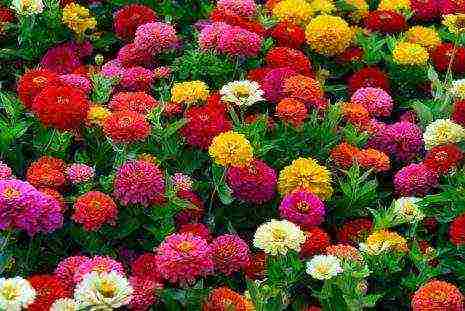
Can annual dahlias be made perennial?
Since Mexico is the homeland of this beautiful perennial flower, the plant cannot survive the conditions of our winters on its own. And therefore, he needs to overexpose before the onset of stable heat.Therefore, if you save the formed tubers until spring, then annual dahlias will become perennial. Of course, provided that the grower has a desire and a place where you can save the thin tubers of annual dahlias.
The appearance of tubers in annual dahlias
Annual dahlias, with good care in nutritious and loose soil, can grow tubers by autumn. Do not be surprised to try to save them until the next warm season, and then they will delight with their lush flowering almost a month earlier from the seed-planted annual dahlias.

Reviews
Nina Petrovna
Has grown many annual dahlias. The first tubers were given to me by my neighbors in the country. They come not only with simple flowers, but also terry and cactus. Still, the roots turn out to be too thin in the fall and in order to preserve them for the next year, special conditions must be created for them.
Tatiana Semyonovna
I grow annual dahlias in my garden and in the fall I dig a bed of flowers and collect dahlia roots for winter storage. There is a lunge, but not so much, so in the spring I plant already sprouted tubers of annual dahlias.
Ekaterina Pogorelova
I would definitely keep these tubers, as they will completely repeat the mother plant. Seeds are flowers at random. True, the bushes grow taller than those that were grown using seedlings from seeds. Therefore, they must be planted in increments of 40 cm.
Delightful dahlia. Tall growth, luscious foliage, gigantic size flower of the most incredible shades. But it is this regal flower that can be found less and less in the garden. And the reason is not only that giant plants need support. More importantly, large dahlia root tubers are difficult to store. And yet it is impossible to completely abandon this plant. Therefore, dwarf forms of dahlias are gaining more and more popularity. They fit perfectly into any flower garden due to the compact shape of the bush, lush greenery and bright, abundant flowering. And root tubers take up little space during storage. In addition, you can opt for an annual dahlia. Previously, we knew only the variety mix "Merry Boys". These dahlias had a loose bush and small, simple flowers. Such a dahlia could only be planted in a rustic-style flower garden.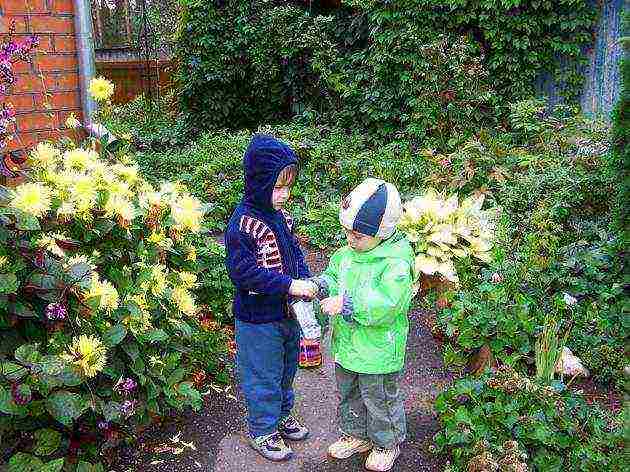
Times are changing, and now the market offers seeds of an annual dahlia with semi-double and double flowers, a dense bush shape, various colors of not only the flower, but also the foliage. Unlike old varieties, modern ones practically do not give splitting of maternal qualities. That is, all varietal characteristics are preserved in the offspring.
Miniature dahlias are very important in my garden. First, they look great in containers. Secondly, they are great in low elegant borders. Thirdly, throughout the season, you can plant dahlias from containers in empty places of vegetable beds and flower beds. The most beloved ones are babies up to 35 cm high and luxurious teenagers up to 50 cm. But taller annual dahlias also easily find their place in a flower garden. For example, the variety mixture "Children of the Cardinal" can reach a height of 80 cm, but the plants have incredibly beautiful foliage of beetroot and chocolate with a bronze tint.
An annual dahlia is most often sold as a mixture of varieties, where seeds of the same variety or hybrid are mixed, but with different flower colors. It was this fact that prompted me to grow an annual dahlia in a perennial culture, keeping the root tubers of the plants I liked in the basement. I have been experimenting with storing the root tubers of the one-year-old dahlia for six years now and there were no reasons for grief, although it is always written in the special literature that it is impossible to preserve such planting material.
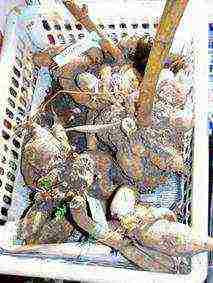
However, with competent agricultural technology, high-quality planting material suitable for storage grows in one season.Moreover, in the second and third years of growing, some plants with simple flowers have an additional 1-2 rows of petals. This happened with the "Children of the Cardinal" and in the second year the simple red flowers became semi-double. So go for it, experiment. If you like the variety and color, be sure to try to preserve the root tuber.
What needs to be done to translate an annual dahlia into a perennial crop? Based on my experience, I can give some recommendations.
Prepare seedling potting soil in early February. I recommend taking the usual ready-made mixture for tomato seedlings, add 3 tablespoons of wood ash, 1 liter of garden humus to 5 liters, mix well, fill containers and pour with phytosporin solution. Place containers in a warm place for 1 week. From mid-February to the second decade of March, you can sow dahlia. In order to get friendly shoots, spread the seeds on warm, moist soil, cover with about 1-2 cm of dried soil, spray the surface with a spray bottle, then cover with foil and place on a light warm (20-22 ° C) windowsill. Dive seedlings with 2-3 true leaves into cassettes or separate cups. As soon as they settle down in their new apartments, start accustoming them to fresh cool air. In an apartment, this can be done on a glazed loggia, covering the plants only when the temperature drops to + 5 ° C. At the dacha or in a country house, already in April, the seedlings can be moved to a warm greenhouse or greenhouse.
Dahlia should be planted in open ground only when the threat of return frosts has passed, or earlier, but with the possibility of shelter, since at 0 ° C the seedlings die. It is impossible to delay planting, since seedlings in closed ground are strongly stretched and weakened.
Dahlias like a sunny, well-protected area from the prevailing winds with rich loamy or well-fertilized sandy soils. The planting site should be prepared in the fall, filled with compost and wood ash. To obtain high-quality root tubers from one-year-old dahlias, seedlings need to be planted only in open ground, in a container the result will be much worse. In the spring, add 2-3 handfuls of compost, 1 tablespoon of the woody zone to the planting pit. After planting, the seedlings must be watered and watering must also be regular throughout the summer. But feeding is strictly regulated. The first is carried out when peduncles appear. To do this, a solution of green fertilizer is sprayed over the leaves. With the onset of active flowering, the plants are fed first with an extract from wood ash, and after 2 weeks with comfrey infusion. In addition, the soil must be loosened and mulched, weeds are removed. To obtain larger inflorescences and root tubers, no more than 3 stems are left in the bush, starting from mid-July, all stepsons are plucked.
Dahlia root tubers are afraid of frost, so many are in a hurry to dig up plants in early September. However, in order to obtain high-quality planting material, it is better to huddle the bushes high at the end of August, and mulch the soil around. After the first frost, throw a non-woven material over the plants at night. After freezing of the aboveground part, it is cut off, and after 3-4 days the root tubers themselves are dug out. They are dried, washed in a phytosporin solution, dried again, and labels are hung. Prepared root tubers are placed in one row in ventilated boxes, sprinkled with peat chips and placed in a dry dark room with a temperature of 4–5 ° С. If the root tubers shrink during storage, the peat is slightly moistened. When weeping parts appear, the planting material is cleaned of diseased areas, washed in a solution of potassium permanganate, dried and sent back for storage.
In the spring, you can either sow new seeds of an annual dahlia, or plant the remaining root tubers, knowing exactly what variety it is, how tall the plants will be and what color and shape it has flowers. And most importantly, you do not have to spend money on the purchase of planting material for border or potted dahlias.

